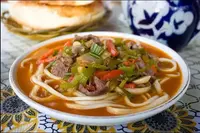The uigur

"Whoever is moderate in food is cheerful - healthy. "
In his words, the famous Uyghur philosopher Yusuf Balasaguni clearly identified the main feature of Uyghur cuisine.
In ancient times, Uighurs said that "food should be eaten moderately and only when you really feel hunger. "
And food, in turn, must be satisfying and necessarily healthy. Uyghurs are considered one of the oldest peoples who live in our time in the territory of East Turkestan. True, modern Uighur lands are part of China and form the autonomous region of Xinjiang Uygur.
Recipes for Uighur cuisine have passed a great test of time. Beginning in early AD, the first Uyghur settlers laid the foundation for Uyghur cuisine. Over time, Uyghur cuisine absorbed traditions and east and west, but the great culinary skills of the Uyghurs remained unchanged, as did the harmonious taste and rich aroma of food.
In the culinary tradition of Uighurs, the following areas can be distinguished. Cold and hot dishes of Uyghur cuisine, as well as snacks and desserts. Most cold dishes of Uyghur cuisine are made on a vegetable basis.
Radishes, tomatoes, peppers, beans, carrots and cabbage are considered the main components of Uyghur salads, which are necessarily seasoned with spices, vinegar and spices. Uyghur salads made of cooked vegetables also enjoy no less popularity.
Uyghur snack Gul Tawak, prepared in the form of vegetable, meat or fish assortment, which is served in the form of a flower, so often such a snack is called a floral dish. Hot dishes of Uyghur cuisine include soups and broths in the first place.
Famous for the Uyghur cuisine recipe for cooking meat broths with Shova and Suyuk ash noodles. Uighurs are famous for their noodles, which are made from dough in the form of a swallow tongue. The dish is a favorite of Uighur noodle cuisine, Lagman, which is made by their thin strands of dough. It is customary to serve various sauces and gravy to the langman.
At various times of the year, Uighurs prepare gravy for Lagman using spring onions, cucumbers and garlic leaves, with radishes, celery, carrots and kohlrabi. Manti can match the popularity of Uighur noodles.
Uyghur manti are steamed in a special reed dish with gimbil. Uighurs make manti from fresh or yeast dough, the filling can be meat and vegetable and even cheese. Among the hot dishes of Uyghur cuisine, you can also single out pilaf, which, however, is usually prepared for guests.
Baking has a special place in Uyghur cuisine. It is worth trying Samsu pies filled with minced meat, vegetables or fruits, which are served for dessert. According to the recipes of Uyghur cuisine, you can prepare Porya or cheburek, which is filled with herbs, cabbage, cilantro, dill, as well as sprouts of sprouted wheat. Goszcz nan are meat pies with onions, they are baked only in Kazan.
And the latest Uighur nan Olukh is a carrot and pumpkin roll that has been steamed. In the Uyghur culinary tradition, bread occupies a special place. Uyghur bread is baked from a mixture of wheat and corn flour, sour or yeast dough is kneaded.
In Kazan, Uyghur chefs cook most of their dishes. Flatbreads made of sauté puff pastry, pancakes with lard and even sanza cookies. Among the national drinks of the Uighurs can be distinguished black tea, which has been brewed since time immemorial, because it was through these lands that the famous Silk Road passed. Uighurs themselves like to drink a couple of cups of strong black tea and milk during the day.
 Español
Español Français
Français Português
Português Русский
Русский 简体中文
简体中文 繁體中文
繁體中文 日本語
日本語 한국어
한국어 العربية
العربية Türkçe
Türkçe Қазақ
Қазақ Deutsch
Deutsch Italiano
Italiano Українська
Українська
